Warm-season ornamental grasses such as Miscanthus and fountain grass (Pennisetum) resent being dug, divided and replanted in the fall. It is best to wait until early spring. As a general…
October #14 (Outdoor)
October #13 (Outdoor)
October is the preferred time to plant ornamental kale, Swiss chard, and pansies. These plants are lovely additions to the fall and winter landscape. Plus, they are edible. Look for…
October #12 (Outdoor)
Remember that seasonal mums are more valuable as compost than as “keep-around plants,” after they’ve faded and split. Don’t be tempted to plant them! Even if they establish, they rarely…
October #11 (Outdoor)
To make leaf removal less of a chore, rake them before they accumulate deeply. If you have a fescue lawn or moss garden, it is even more important to keep…
October #10 (Outdoor)
Pick off any bagworms from your plants to help eliminate the eggs that will hatch next year. Dispose of them in the garbage, not the compost, or they may hatch…
October #9 (Outdoor)
Other perennials can be mulched with a thin layer of organic material, but keep the mulch away from the crown or it could hold too much moisture and rot the…
October #8 (Outdoor)
After frost, you can cut back your deciduous herbaceous perennials to lessen the chance of disease or insects overwintering in your beds. Hardy lantanas and salvias are perennials that are…
October #7 (Outdoor)
Don’t forget to bring in your tropical plants and houseplants before frost. Many plants don’t fare well when temperatures drop into the 40s.
October #6 (Outdoor)
October is a good time for you “yardeners” to control broadleaf weeds, such as white clover and wild garlic. Check with you county Extension office for specific recommendations.
